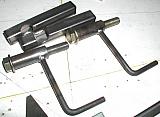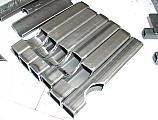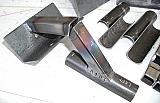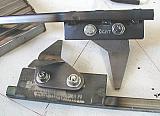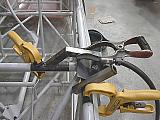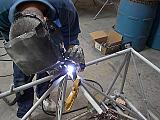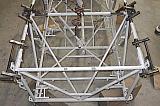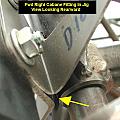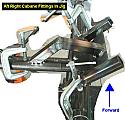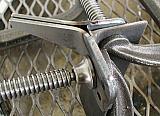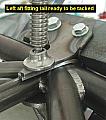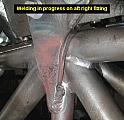Cabane Fitting Jigs
Using a Kimball fuselage as a master guide, I made a set of jigs for locating and welding the 4 sets of cabane fittings on the fuselage. It is important to note that the cabane struts are of fixed length, so the fittings must be set correctly. Otherwise, the upper wing must be set in position and custom length cabane struts fitted. Using the jigs allows me to use the cabane struts I bought from Kevin preassembled.
Normally, these jigs will are available for use by other builders. To find out their current location contact me.


Building the Jigs
Installing the Fittings
So you're just about to start putting the cabane fittings on your fuselage, and have some questions. Maybe the following discussion with Kevin will help....
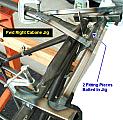 QUESTION: Kevin, you can see where I'm at on this, but I'm a little unsure how to proceed. If you don't mind, could
you please give me a step-by-step on how you would put these things on? I will include your instructions with the jigs when they
get passed on to the next builder.
QUESTION: Kevin, you can see where I'm at on this, but I'm a little unsure how to proceed. If you don't mind, could
you please give me a step-by-step on how you would put these things on? I will include your instructions with the jigs when they
get passed on to the next builder.
ANSWER: Here is how we do it. We bolt all the cabane fitting parts to the jig (ours is one jig that holds all at one time instead of 4 jigs like yours). Fit to the frame like you have them. All parts on though including the aft outers. The fitting tails will stick out a bit on the sides and up on the front inners. This is perfect. Edge seam weld as much of all the 2 ply areas from the bends up and around the bolts NOT on the rear outer tails at this time. You won't be able to do all the edges, but get at the front and back edges at least. Now the fitting assemblies are stuck together. Now use a C clamp to pull the front 2 outer tails tight to the vertical tubes. Tack across the bottom point end. Good strong tack. Now C Clamp the 2 rear lower pairs to the vertical tube and tack them good as on front ones. Here is where you get to use the gas torch rig. Use the rosebud tip to heat the 4 outer tails front and re ar and hammer form them to the curve of the tubes and tuck in at the longeron. We try to hit the fittings only on the edges where the welding will burn up the material so that the hammer marks will not show later. Next heat up the the top front .063 tail and form it down around the longeron and to the cross tube. Tack point and heat and form more if needed. Now weld up all you can with the jig on. Should get 90+% of it while jigged. Remove jig and finish welding.
QUESTION: Do these gaps just get filled in with mass quantities of filler rod?
ANSWER: Not Mass Quantities, but just what it takes to plug the end. Don't try to fill all the way thru the fitting gap.


